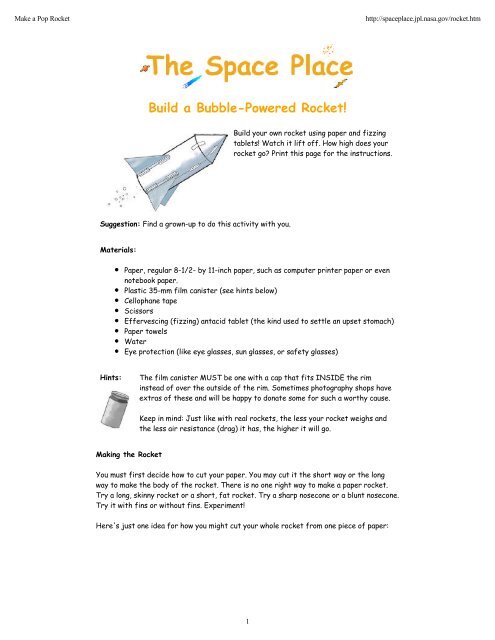Build a Bubble-Powered Rocket! - ER - NASA
Build a Bubble-Powered Rocket! - ER - NASA
Build a Bubble-Powered Rocket! - ER - NASA
Create successful ePaper yourself
Turn your PDF publications into a flip-book with our unique Google optimized e-Paper software.
Make a Pop <strong>Rocket</strong><br />
http://spaceplace.jpl.nasa.gov/rocket.htm<br />
<strong>Build</strong> a <strong>Bubble</strong>-<strong>Powered</strong> <strong>Rocket</strong>!<br />
<strong>Build</strong> your own rocket using paper and fizzing<br />
tablets! Watch it lift off. How high does your<br />
rocket go? Print this page for the instructions.<br />
Suggestion: Find a grown-up to do this activity with you.<br />
Materials:<br />
Paper, regular 8-1/2- by 11-inch paper, such as computer printer paper or even<br />
notebook paper.<br />
Plastic 35-mm film canister (see hints below)<br />
Cellophane tape<br />
Scissors<br />
Effervescing (fizzing) antacid tablet (the kind used to settle an upset stomach)<br />
Paper towels<br />
Water<br />
Eye protection (like eye glasses, sun glasses, or safety glasses)<br />
Hints:<br />
The film canister MUST be one with a cap that fits INSIDE the rim<br />
instead of over the outside of the rim. Sometimes photography shops have<br />
extras of these and will be happy to donate some for such a worthy cause.<br />
Keep in mind: Just like with real rockets, the less your rocket weighs and<br />
the less air resistance (drag) it has, the higher it will go.<br />
Making the <strong>Rocket</strong><br />
You must first decide how to cut your paper. You may cut it the short way or the long<br />
way to make the body of the rocket. There is no one right way to make a paper rocket.<br />
Try a long, skinny rocket or a short, fat rocket. Try a sharp nosecone or a blunt nosecone.<br />
Try it with fins or without fins. Experiment!<br />
Here's just one idea for how you might cut your whole rocket from one piece of paper:<br />
1
Make a Pop <strong>Rocket</strong><br />
http://spaceplace.jpl.nasa.gov/rocket.htm<br />
Here are the basic steps:<br />
1. Cut out all the pieces for your rocket.<br />
2. Wrap and tape a tube of paper around the film canister. Hint:<br />
Tape the canister to the end of the paper before you start<br />
wrapping.<br />
Important! Place the lid end of the canister down.<br />
3. Tape fins to your rocket body, if you want.<br />
4. Roll the circle (with a wedge cut out) into a cone and tape it to the rocket's top.<br />
Blasting Off<br />
1. Put on your eye protection.<br />
2. Turn the rocket upside down and remove the canister's lid.<br />
3. Fill the canister one-third full of water.<br />
Now work quickly on the next steps!<br />
1. Drop one-half of an effervescing antacid tablet into the canister.<br />
2. Snap the lid on tight.<br />
3. Stand your rocket on a launch platform, such as your sidewalk or driveway.<br />
4. Stand back and wait. Your rocket will blast off!<br />
2
Make a Pop <strong>Rocket</strong><br />
http://spaceplace.jpl.nasa.gov/rocket.htm<br />
So, Dr. Marc, how does the pop-rocket<br />
work?<br />
When the fizzy tablet is placed in water, many little<br />
bubbles of gas escape. The bubbles go up, instead of down,<br />
because they weigh less than water. When the bubbles get<br />
to the surface of the water, they break open. All that gas that has escaped from the<br />
bubbles pushes on the sides of the canister.<br />
Now when you blow up a balloon, the air makes the balloon stretch bigger and bigger.<br />
But the little film canister doesn't stretch and all this gas has to go somewhere!<br />
Eventually, something has to give! So the canister pops its top (which is really its<br />
bottom, since it's upside down). All the water and gas rush down and out, pushing the<br />
canister up and up, along with the rocket attached to it.<br />
Real rockets work kind of the same way. But instead of using tablets that fizz in<br />
water, they use rocket fuel.<br />
Delta rocket similar to the one that launched the Deep<br />
Space 1 spacecraft from Cape Canaveral, Florida, in<br />
October 1998.<br />
The rocket that launched Deep Space 1 on October 24, 1998, had four different<br />
kinds of engines. Some pushed the rocket off the ground. Then some helped it<br />
continue its climb into space. Others gave the Deep Space 1 spacecraft its final push<br />
away from Earth. But all of them forced a gas to shoot out of the rocket, thus<br />
pushing the rocket the other way.<br />
We call this wonderful and useful fact the law of action and reaction. The action is<br />
the gas rushing out of the rocket. The reaction is the rocket taking off in the other<br />
direction. In other words, for every action there is an equal and opposite reaction.<br />
The rocket goes in the opposite direction from the gas, and the faster the gas<br />
leaves the rocket, the faster the rocket gets pushed the other way.<br />
3

















